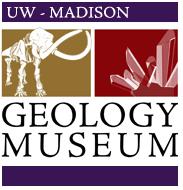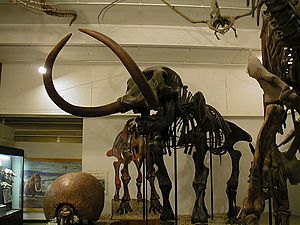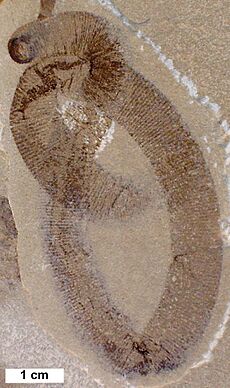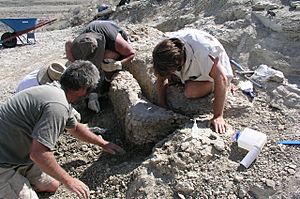UW–Madison Geology Museum facts for kids
 |
|
| Type | Natural history museum |
|---|---|
| Public transit access | |
The UW–Madison Geology Museum is a museum full of amazing rocks, minerals, and fossils. It is located on the campus of the University of Wisconsin–Madison. The museum's main goals are to create cool exhibits, teach the public about geology, and support scientific research. It's one of the most popular museums at the university, and the best part is, it's free to visit!
Contents
Museum History
The museum first started in the 1800s. For a long time, it was located in a building called Science Hall. In the 1970s, a new building called Weeks Hall was built for the geology department. The museum moved to its current home in Weeks Hall in 1981.
Amazing Exhibits to Explore
The museum has 66 different exhibits that are packed with almost 1,000 interesting items. The main sections show off rocks and minerals, fossils of creatures without backbones (invertebrates), fish fossils, and fossils of animals with backbones (vertebrates). You can also see exhibits about glaciers, meteorites, and ancient plants.
Cool Rocks and Minerals
Some of the neatest things you can see in the rock section are:
- A beautiful and rare mineral called kermesite.
- Two huge pieces of copper, known as glacial erratics, that each weigh hundreds of pounds.
- A special case with 85 different minerals that were recently donated to the museum.
- A blacklight room where you can see rocks glow in the dark! When you shine an ultraviolet light on them, they show off amazing colors. This is called fluorescence and phosphorescence.
- A walk-through model of a limestone cave. It even has sound effects to make you feel like you're really exploring underground.
Fantastic Fossils
The fossil collection is full of incredible ancient life forms:
- A giant slab of a Cretaceous sea floor from Texas. You can see the imprints of many clams that lived millions of years ago.
- Giant shells from an ancient squid-like creature called Endoceras that was found in Wisconsin.
- The very first specimen ever found of a fossil cephalopod named Actinoceras beloitense. This is called a type specimen and is very important for science.
- A window where you can watch scientists at work in the preparation lab. They carefully clean fossils that have been brought back from the field.
- Models of strange animals from the Burgess Shale, a famous fossil site. You can see creatures like Pikaia, which might be an early relative of ours, and the giant predator Anomalocaris.
- Several skeletons from the Cretaceous period found in the Niobrara chalk of Kansas:
- Hesperornis, a swimming bird that had teeth.
- A slab of chalk containing the fossil of a shark called Squalicorax. You can see its teeth, vertebrae, and even the bones of its last meal!
- A beautifully preserved slab of a floating colony of crinoids, which are also known as sea lilies.
- A nearly complete skeleton of a Platecarpus, a type of mosasaur (a giant sea reptile), hanging from the ceiling. This fossil shows signs of old injuries, including broken ribs and arthritis in one of its flippers.
- A replica of a Pteranodon, a type of flying reptile called a pterosaur, also hanging from the ceiling.
- Skeletons of other vertebrates:
- Captorhinus, a reptile from the Permian period.
- A skeleton of the duck-billed dinosaur Edmontosaurus. This was the first dinosaur ever put on display in Wisconsin.
- The skeleton of an American mastodon, a relative of the elephant that lived during the Pleistocene ice age. The skeleton is made from the bones of two different mastodons found in Wisconsin in the 1890s. Because one was found near a town called Boaz, it is often called the Boaz mastodon.
Signs of Early Life
This exhibit shows the history of Earth and the clues that life has left behind over billions of years.
- A block of rock containing pieces from the Sudbury impact, a massive meteorite crash that happened 1.85 billion years ago.
- Stromatolites, which are layered fossils made by ancient bacteria. These are from the Ordovician period and were found in Wisconsin.
- Fossils of soft-bodied creatures, like a mysterious organism called Grypania and an ancient worm from the Silurian period.
Treasures from Outer Space
- A large piece of the Canyon Diablo meteorite. This is the meteorite that created the famous Meteor Crater in Arizona.
- Several smaller meteorites that have fallen in Wisconsin.
Learning and Fun for Everyone
Each year, hundreds of school groups visit the museum for tours led by university students. Museum staff also visit schools to teach kids and teachers all about geology.
The museum holds special family events, like its yearly Open House. These events often have a fun theme. For example, one year the theme was pterosaurs, and another year it was the strange fossils from Mazon Creek, including the famous Tully Monster (Tullimonstrum gregarium).
Scientific Research and Discovery
The museum's scientists go on fossil digs in many western states. They have found amazing marine fossils in Kansas and dinosaur bones in Montana and South Dakota. These include duck-billed dinosaurs, horned dinosaurs, and even tyrannosaurids.
Every summer, the museum team digs for fossils in the Jurassic Morrison Formation in Wyoming. They have found sauropod (long-necked) and theropod (meat-eating) dinosaurs there.
The museum also does research closer to home. For example, they study the fossils of Pleistocene mammals found in caves throughout the Midwestern United States.
Behind the Scenes Collections
Like most museums, the Geology Museum has many more items in storage than on display. The collection includes most of the meteorites ever found in Wisconsin. It also has thousands of rocks and minerals collected by scientists or donated by friends of the museum.
The fossil collection is huge. It includes fossils from the White River Badlands, the Cretaceous Hell Creek Formation, and a special collection of Silurian soft-bodied fossils from a quarry near Waukesha.




